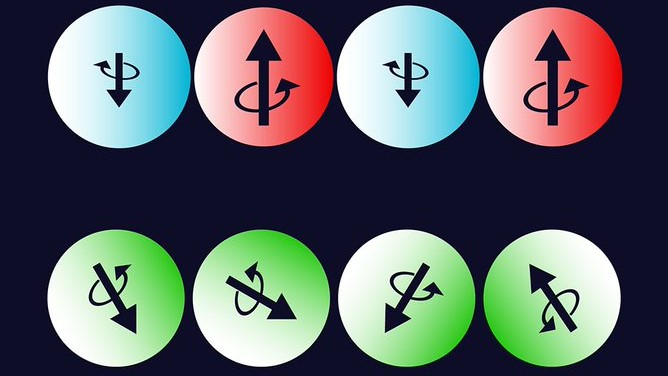
The performance of some quantum technologies could be boosted by exploiting interactions between nitrogen-vacancy (NV) centres and defects on the surface of diamond – according to research done by two independent teams of scientists in the US.
NV centres in diamond have emerged as a promising solid-state platform for quantum sensing and information processing. They are defects in the diamond lattice in which two carbon atoms are replaced with a single nitrogen atom, leaving one lattice site vacant. NV centres are a two-level spin system into which quantum information can be written and read out using laser light and microwaves. An important property of NV centres is that once they have been put into a specific quantum state, they can remain in that state for a relatively long “coherence” time – which makes them technologically useful.
Very sensitive
NV centres are very sensitive to magnetic fields, which means that they can be used to create high-performance magnetic field sensors for a wide range of applications. However, this sensitivity has its downside because sources of magnetic noise can degrade the performance of NV centres.
One source of magnetic noise are the interactions between NV centres and the spins of unpaired electrons on the surface of diamond. These spins cannot be detected using optical techniques, so they are referred to as “dark spins”.
As they interact with NV centres, dark spins can destroy quantum information that is stored in an NV centre or reduce the performance of NV-based sensors. Such interactions can be minimized by using NV centres that are deeper inside the bulk of the diamond. However, this solution makes it more difficult to use them to sense magnetic fields over very short length scales – something that is useful for studying individual spins, nuclei or molecules.
Technologically useful
Because of the difficulty of detecting dark spins, their behaviour has mostly remained a mystery. However, previous studies have shown that dark spins have long coherence times, which could make them useful in quantum technologies.
Both teams probed interactions between NV centres and dark spins using double electron-electron resonance (DEER). This is a technique that determines the distance between pairs of electron spins by applying microwave pulses to both simultaneously.
One team led by Nathalie de Leon at Princeton University used DEER measurements to develop a model of how NV centre coherence times vary with their depth below the surface of diamond. The team also discovered that the dark spins are not static, but instead “hop” between sites on the surface. These discoveries suggest that NV-based technologies could be optimized by selecting an appropriate depth for the NV centres – and by developing ways to control the hopping of dark spins.
Chemical vapour deposition
Meanwhile a team led by Norman Yao at the University of California, Berkeley used similar techniques to explore how NV centres interact with a different type of dark spin called P1s. These were created on a diamond surface by the chemical vapour deposition of nitrogen.

The diamond quantum revolution
In one experiment the researchers prepared a sparsely populated bath of P1s so that mutual interactions between NV centres dominated over the influence of the P1s. In this case, they could use microwave pulses to selectively decouple the NV centres either from each other, or from the impurities. This study revealed that in this case interactions between NV centres dominated the decoherence process, rather than interactions between NV centres and the P1s.
However, when Yao and colleagues prepared a denser bath of P1s, they could use the interactions to exchange quantum information between the NV centres and the P1s. This rich quantum environment could be particularly useful for performing quantum simulations that involve many interacting spins – including complex biomolecules and exotic states of matter.
Yao’s team describes its work in a paper on arXiv that has been accepted for publication in Nature Physics. De Leon and colleagues present their findings in Physical Review X.
